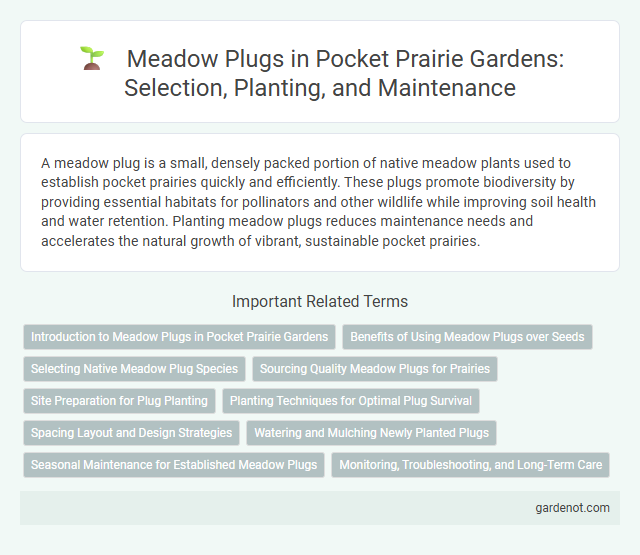A meadow plug is a small, densely packed portion of native meadow plants used to establish pocket prairies quickly and efficiently. These plugs promote biodiversity by providing essential habitats for pollinators and other wildlife while improving soil health and water retention. Planting meadow plugs reduces maintenance needs and accelerates the natural growth of vibrant, sustainable pocket prairies.
Introduction to Meadow Plugs in Pocket Prairie Gardens
Meadow plugs are young plants specifically cultivated to establish diverse native wildflower meadows in pocket prairie gardens. These plugs enable gardeners to create sustainable habitats by promoting biodiversity, supporting pollinators, and requiring less maintenance than traditional lawns. Using meadow plugs in pocket prairie designs enhances ecological value and provides vibrant, seasonal color throughout the year.
Benefits of Using Meadow Plugs over Seeds
Meadow plugs offer faster establishment and greater initial survival rates compared to seeds, ensuring a robust pocket prairie with less maintenance. These plugs provide immediate biodiversity by introducing mature plant roots and soil microorganisms, which enhance soil health and resilience. Using meadow plugs reduces weed competition and erosion risk, creating a stable habitat for pollinators and local wildlife more quickly than seed sowing.
Selecting Native Meadow Plug Species
Selecting native meadow plug species for a pocket prairie involves identifying local plant varieties that thrive in the specific climate and soil conditions of the region. Native grasses and wildflowers such as little bluestem, black-eyed Susan, and purple coneflower promote biodiversity, improve soil health, and support pollinators. Incorporating a diverse mix of these species ensures resilience and sustainability in the pocket prairie ecosystem.
Sourcing Quality Meadow Plugs for Prairies
Sourcing quality meadow plugs for prairies involves selecting native plant species that are well-adapted to local climates and soil conditions, ensuring robust growth and biodiversity. High-quality meadow plugs are typically grown from seed in controlled environments, promoting healthy root systems and reducing transplant shock. Partnering with reputable native plant nurseries that specialize in region-specific prairie species guarantees ecological compatibility and long-term sustainability of the pocket prairie ecosystem.
Site Preparation for Plug Planting
Site preparation for meadow plug planting involves clearing existing vegetation and loosening the soil to create an optimal environment for root establishment. Removing weeds and compacted layers enhances water infiltration and nutrient access crucial for plug growth. Properly prepared sites increase plug survival rates and promote dense, diverse meadow development.
Planting Techniques for Optimal Plug Survival
Meadow plug planting techniques emphasize proper soil preparation and hydroseeding to enhance root establishment and maximize plug survival. Spacing plugs at 6 to 12 inches ensures sufficient room for growth while reducing competition for nutrients and water. Consistent irrigation during the initial establishment phase is crucial to prevent drought stress and promote vigorous root development, leading to a thriving pocket prairie ecosystem.
Spacing Layout and Design Strategies
Meadow plug spacing layout and design strategies emphasize plant density to optimize growth and biodiversity in pocket prairies. Proper spacing ensures adequate sunlight penetration and root expansion, supporting a healthy ecosystem with native grasses and wildflowers. Strategic placement of plugs reduces competition, enhances soil stability, and promotes pollinator habitats essential for sustainable prairie restoration.
Watering and Mulching Newly Planted Plugs
Watering newly planted meadow plugs requires consistent moisture to establish strong roots, ideally maintaining damp but not waterlogged soil. Mulching around the plugs with organic materials like straw or shredded bark helps retain soil moisture and suppress weeds that compete for nutrients. Proper watering and mulching techniques significantly improve plug survival rates and promote rapid growth in pocket prairie restoration projects.
Seasonal Maintenance for Established Meadow Plugs
Seasonal maintenance for established meadow plugs involves targeted mowing, irrigation, and weed control to promote healthy growth and biodiversity. Regular mowing during late fall or early spring helps remove dead plant material and stimulates new shoots, while supplemental watering supports plug establishment during dry periods. Monitoring and removing invasive weeds prevent competition and ensure the meadow plug thrives within the pocket prairie ecosystem.
Monitoring, Troubleshooting, and Long-Term Care
Meadow plugs require regular monitoring to ensure healthy establishment and detect early signs of stress or pest infestation. Troubleshooting involves addressing issues such as inadequate moisture, soil compaction, or invasive species encroachment to promote robust growth. Long-term care includes periodic replanting, soil health assessment, and controlled mowing to maintain biodiversity and ecological balance in the pocket prairie.
Meadow plug Infographic

 gardenot.com
gardenot.com